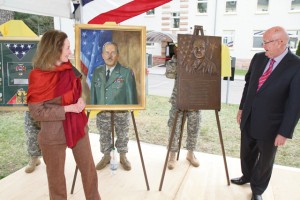
Christa Dirgins and retired Gen. Gordon Sullivan unveil a shadowbox, painting and plaque dedicated to the late Brig. Gen. Richard Dirgins April 17 at Daenner Kaserne.
Memories surfaced in retired Gen. Gordon R. Sullivan’s speech as he recalled his friend, Brig. Gen. Richard Dirgins, during an April 17 ceremony at Daenner Kaserne.
The 7th Civil Support Command’s headquarters building was named for Dirgins, who passed away in 1995, just six months after leaving command of the unit’s predecessor, the 7th Army Reserve Command.
“Our purpose here today is to rededicate this building in honor of Richard Dirgins, my classmate, my friend and a great American Soldier, a patriot,” said Sullivan, who attended Norwich University in Vermont alongside Dirgins. “I have such fond memories of him.”
Dirgins’ widow, Christa, and senior U.S. and German leaders watched as a plaque and portrait of Dirgins were unveiled. A new sign outside the building bears Dirgins’ name.
Dirgins was commanding general of the 7th ARCOM from Dec. 25, 1987 to July 10, 1994. Based at the time in Schwetzingen, Germany, the 7th ARCOM evolved into the 7th CSC, the U.S. Army Reserve’s only forward-stationed reserve command in Europe.
During his tenure, the command grew from two to 23 units, increased its strength from 260 soldiers to almost 1,000 and deployed five units to southwest Asia in support of Operations Desert Shield and Storm.
Sullivan, who was the 32nd Army Chief of Staff from 1993 to 1995, said Dirgins was a key leader in the development of the USAR.
With tears in his eyes, Sullivan, a native of Quincy, Massachusetts, warmly re-called his lifelong friendship with Dirgins. He spoke of their days at Norwich University and time spent together serving as Army captains in Germany.
Sullivan recalled his first assignment in Germany when he sailed to the port in Bremerhaven, took a train to Frankfurt and then rode in a truck to Ray Barracks in Friedberg.
“I got out of the truck and Dick Dirgins was there, sitting in a Porsche,” Sullivan said.
Sullivan, who now serves as the president and chief executive officer of the Association of the United States Army, explained that Dirgins remained in Europe, raised a family and continued his loyal service with the Army Reserve. Many people in the audience could relate, as they have done the same.
Having reserve forces in Europe helps U.S. commanders support expanding NATO reach in central Europe and elsewhere in the region, Sullivan said.
“I’ve got to tell you folks, organizations like the 7th CSC are critical to the well-being, and to enable the commanders here,” he said. “We’re still here; we’re still paying attention, and the 7th CSC is a part of it.”
Sullivan spoke to the crowd of hundreds who gathered for the ceremony commemorating Dirgins’ 1995 funeral which took place under the clear skies in Bavaria.
“To the best of my knowledge, Dick may be the only American general officer buried in this country,” Sullivan said. “That will show you his dedication to this alliance and to the Federal Republic of Germany. He loved it here.”
In his remarks, Brig. Gen. Arlan DeBlieck, 7th CSC commanding general, said the event celebrated one of the Army Reserve’s premier leaders who established a profession of arms culture which enabled the reserves to integrate into the total USAR today.
“Today, the 7th CSC supports the total Army and NATO forces in building and maintaining a ‘strong Europe’ and deterring potential aggressors to preserve peace in Europe,” DeBlieck said. “We honor Brig. Gen. Richard Dirgins, who as the 7th’s commanding general for almost seven years, set the conditions for the 7th’s success.”


